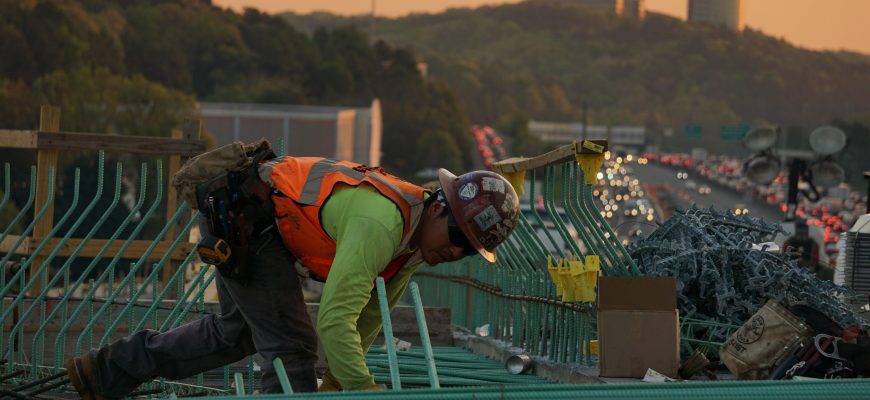
By Henry Cisneros and Sarah Rosen Wartell, Academy Fellows.
On November 15, 2021, President Biden signed the Infrastructure Investment and Jobs Act (IIJA). The IIJA will provide $550 billion in new investments in addition to $423 billion in reauthorizations for infrastructure spending over five years. With successful implementation, the IIJA could create millions of jobs over the coming years and create new opportunities for people who have been sidelined and unable to connect to meaningful work.
But a critical question often goes unasked and unanswered: Who will do this work? Today, the United States faces a labor shortage. We are in a full-employment economy with an unemployment rate of 3.8 percent. And while rising, the overall labor force participation rate is lower than it was before the pandemic. In this tight labor market, the nation’s employers already have a hard time finding workers. The labor shortage is a particular problem in skilled trades where more than three-quarters of tradespeople view the labor shortage as a problem. Coupled with a shortage of supplies and materials, they have been unable to meet the demand for their services or grow their businesses. The Homebuilders Institute estimates that the industry will need to fill 2.2 million more positions over the coming three years to support new home construction.
Compounding the shortage of workers is the lack of new funding for workforce development. Although the IIJA provides some support for digital training and apprenticeship programs, the proposal to provide $100 billion to support training more broadly was dropped before passage. The Build Back Better legislation would have provided $40 billion for workforce training programs, but this legislation does not have not enough support in Congress to pass.
Recognizing the urgency of these issues, the Center for Intergovernmental Partnerships at the National Academy of Public Administration in February brought together experts with track records of finding and training the workers necessary to execute critical infrastructure projects. Speakers from the private sector, county, state, and federal agencies agreed that more effective collaboration and coordination would be needed to ensure the nation could meet its infrastructure workforce needs.
Apprenticeships are the flagship on-the-job training that leads to a credential. The U.S. Department of Labor, through the Employment Training Administration, provides financial and technical assistance to states and localities providing workforce training services. The Labor Department recently announced its intention to award $113 million in grants to support registered apprenticeship programs. It also maintains a repository of information on apprenticeships for career seekers, employers, and educators.
In Missouri, apprenticeships are an essential part of the workforce strategy. The Missouri Department of Higher Education & Workforce Development meets several times each year with educators, employers, and workforce partners from across the state to identify and address their communities’ needs. Just last month, the state announced the Project Eagle Apprenticeship Program to qualify military training and experience towards a federally-recognized apprenticeship certification. Members of the state’s National Guard can now complete job-learning hours while fulfilling their service obligations.
Community colleges also play an important role in workforce training, providing the knowledge, skills, and credentials that allow students to find meaningful work. They also put education within reach for many low-income students. According to the National Association of Counties (NACo), one-quarter of counties fund higher education in their communities. Investments in workforce development are a significant component of that support. Counties have long been on the front lines of workforce development issues as they connect residents with training and other social safety net programs. NACo also reports that these training programs and other strategies to reduce barriers to employment can improve equity.
Communication and outreach strategies can be crucial in supporting workforce development programs. Physically meeting people where they are through mobile service centers and using multiple modes of communication can improve contact with the hard-to-reach. For example, the District of Columbia has created Workforce on Wheels, bringing American Job Center resources to communities that need them.
Making sure we have an adequate workforce to build infrastructure is the responsibility of every level of government. In the 21st Century, no significant public problem fits entirely within one government agency or even one level of government, and our federal system presupposes that all levels of government have an important role in the democratic process. The national workforce system is a complex network of federal programs implemented through grants to state and local partners. Universities and community colleges, employers, community leaders, state licensing boards, and unions all also have vital roles to play. Intergovernmental relationships can amplify the efforts at each level and help close the gap between employer needs and the available workforce.
IIJA implementation will require that our entire intergovernmental system operates effectively to ensure that everyone can be connected to meaningful work that enhances economic prosperity. These collaborations are more important than ever as we deal with challenges that can only be addressed by the full engagement of all partners in the intergovernmental system. The CIP is perfectly positioned to connect all the players to help design better solutions. This work is essential, and that’s why we signed up.
